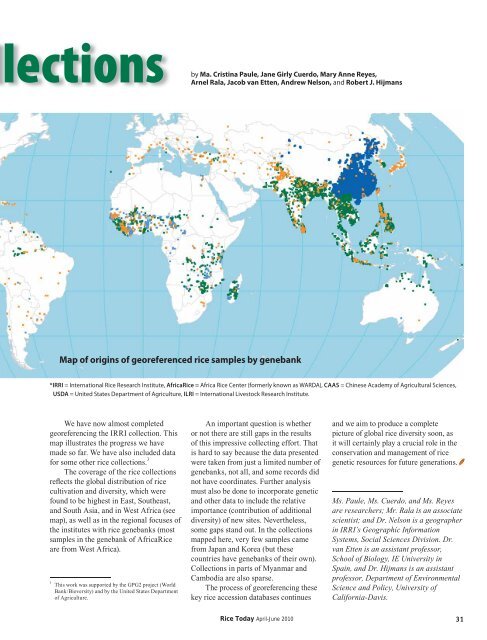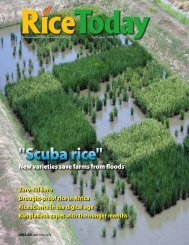MAPSMapp<strong>in</strong>g genebank colThe genetic diversity <strong>in</strong> traditional The samples <strong>in</strong> genebanks, andand modern rice varieties, and <strong>in</strong> their associated data, can also be used tothe wild relatives <strong>of</strong> rice, is vital further explore and discover geographicto agricultural development, as it patterns <strong>in</strong> crop diversity. In fact, theseprovides the basis for rice improvement. patterns are used to reconstruct theSometimes, a s<strong>in</strong>gle rare gene found prehistorical orig<strong>in</strong>s and spread <strong>of</strong> crops.<strong>in</strong> only a few varieties can greatly These data can be used to narrow downcontribute to rice production. A good the geographical search area <strong>in</strong> f<strong>in</strong>d<strong>in</strong>gexample <strong>of</strong> this is the short-straw gene or samples with important traits, such as athe SUB1 gene that confers submergence certa<strong>in</strong> type <strong>of</strong> disease resistance. Thetolerance.data also serve to identify gaps <strong>in</strong> aIronically, the success <strong>of</strong> rice genebank collection, for which collect<strong>in</strong>gbreed<strong>in</strong>g has rapidly replaced traditional expeditions are still needed.varieties with modern ones, particularly Such analyses are possible only<strong>in</strong> Asia’s irrigated rice fields. Thus, the if we have a decent database <strong>in</strong>use <strong>of</strong> crop diversity bites its own tail, which each sample is described. Cropbecom<strong>in</strong>g a threat to its persistence. descriptors can <strong>in</strong>clude morphologicalOne important approach to avoid the characteristics, agronomic traits, andloss <strong>of</strong> crop biodiversity, or “genetic genetic data. For geographic analysis, iterosion,” is the use <strong>of</strong> genebanks. A is crucial also to know where the samplegenebank assembles a broad collection was taken from.<strong>of</strong> rice varieties and conserves themFortunately, “passport” <strong>in</strong>formationfor breed<strong>in</strong>g. In total, there are 780,551 such as name <strong>of</strong> species, common name,samples <strong>of</strong> rice <strong>in</strong> genebanks. The <strong>in</strong>stitute code, date <strong>of</strong> acquisition,International Rice Research Institute and location is generally available <strong>in</strong>(IRRI) has 109,136 samples, while genebank databases. However, for manygenebanks <strong>in</strong> India and Ch<strong>in</strong>a have samples, no geographic coord<strong>in</strong>ates are86,119 and 70,104 samples, respectively. 1 available. Most samples were collected*Georeferenc<strong>in</strong>g. This refers to the process <strong>of</strong> convert<strong>in</strong>g text descriptions <strong>of</strong>locations to geographic coord<strong>in</strong>ates that can be used <strong>in</strong> an analysis. This <strong>in</strong>volvesbreak<strong>in</strong>g down a description such as “14 kilometers north and 2 kilometers west<strong>of</strong> La Paz, Tarlac, Luzon, Philipp<strong>in</strong>es” <strong>in</strong>to its geographic components, which canthen be used to assign a coord<strong>in</strong>ate to the record—<strong>in</strong> this case, 15.578N, 120.704E.However, process<strong>in</strong>g such <strong>in</strong>formation is not always as straightforward as thisexample. Records <strong>of</strong>ten struggle with variations <strong>in</strong> spell<strong>in</strong>gs, obsolete names, andsometimes misspelled entries.Deal<strong>in</strong>g with <strong>in</strong>accurate or wrong location data. Records that do havelocation data are also checked for errors. Some common errors are mistak<strong>in</strong>glongitude for latitude (a mistake probably made from time to time); swapp<strong>in</strong>geast with west or north with south; miss<strong>in</strong>g a latitude or longitude coord<strong>in</strong>ate;truncat<strong>in</strong>g the decimal po<strong>in</strong>ts <strong>in</strong> a coord<strong>in</strong>ate, result<strong>in</strong>g <strong>in</strong> lower precision; orsimply putt<strong>in</strong>g <strong>in</strong> the wrong data. Not all errors can easily be corrected, but wehave corrected those coord<strong>in</strong>ates that fell <strong>in</strong> an ocean, or <strong>in</strong> the wrong country.Needless to say, determ<strong>in</strong><strong>in</strong>g the most likely location for an accession is a timeconsum<strong>in</strong>gtask.before the global position<strong>in</strong>g systembecame available. So, their locationswere simply expressed <strong>in</strong> text format.At IRRI, we have worked on improv<strong>in</strong>gthis situation to ref<strong>in</strong>e the Institute’sgenebank and also other genebanks. Wehave used tools such as biogeomancer 2to assign coord<strong>in</strong>ates to genebanksamples, us<strong>in</strong>g their available textdescription as references. This is called“georeferenc<strong>in</strong>g” (see box). We also crosscheckedthe coord<strong>in</strong>ates and correctedthose that were found to be wrong.12Accord<strong>in</strong>g to "The State <strong>of</strong> the World's Plant GeneticResources for Food and Agriculture," FAO, 2009.Available at www.fao.org/ag/AGP/agps/PGRFA/wrlmap_e.htm.Guarlnick et al. 2006. PLoS Biology. www.plosbiology.org/article/<strong>in</strong>fo:doi/10.1371/journal.pbio.0040381; http://bg.berkeley.edu/latest/.30 Rice Today April-June 2010
lectionsby Ma. Crist<strong>in</strong>a Paule, Jane Girly Cuerdo, Mary Anne Reyes,Arnel Rala, Jacob van Etten, Andrew Nelson, and Robert J. HijmansMap <strong>of</strong> orig<strong>in</strong>s <strong>of</strong> georeferenced rice samples by genebank*IRRI = International Rice Research Institute, AfricaRice = Africa Rice Center (formerly known as WARDA), CAAS = Ch<strong>in</strong>ese Academy <strong>of</strong> Agricultural Sciences,USDA = United States Department <strong>of</strong> Agriculture, ILRI = International Livestock Research Institute.We have now almost completedgeoreferenc<strong>in</strong>g the IRRI collection. Thismap illustrates the progress we havemade so far. We have also <strong>in</strong>cluded datafor some other rice collections. 3The coverage <strong>of</strong> the rice collection<strong>sr</strong>eflects the global distribution <strong>of</strong> ricecultivation and diversity, which werefound to be highest <strong>in</strong> East, Southeast,and South Asia, and <strong>in</strong> West Africa (seemap), as well as <strong>in</strong> the regional focuses <strong>of</strong>the <strong>in</strong>stitutes with rice genebanks (mostsamples <strong>in</strong> the genebank <strong>of</strong> AfricaRiceare from West Africa).3This work was supported by the GPG2 project (WorldBank/Bioversity) and by the United States Department<strong>of</strong> Agriculture.An important question is whetheror not there are still gaps <strong>in</strong> the results<strong>of</strong> this impressive collect<strong>in</strong>g effort. Thatis hard to say because the data presentedwere taken from just a limited number <strong>of</strong>genebanks, not all, and some records didnot have coord<strong>in</strong>ates. Further analysismust also be done to <strong>in</strong>corporate geneticand other data to <strong>in</strong>clude the relativeimportance (contribution <strong>of</strong> additionaldiversity) <strong>of</strong> new sites. Nevertheless,some gaps stand out. In the collectionsmapped here, very few samples camefrom Japan and Korea (but thesecountries have genebanks <strong>of</strong> their own).Collections <strong>in</strong> parts <strong>of</strong> Myanmar andCambodia are also sparse.The process <strong>of</strong> georeferenc<strong>in</strong>g thesekey rice accession databases cont<strong>in</strong>uesand we aim to produce a completepicture <strong>of</strong> global rice diversity soon, asit will certa<strong>in</strong>ly play a crucial role <strong>in</strong> theconservation and management <strong>of</strong> ricegenetic resources for future generations.Ms. Paule, Ms. Cuerdo, and Ms. Reyesare researchers; Mr. Rala is an associatescientist; and Dr. Nelson is a geographer<strong>in</strong> IRRI’s Geographic InformationSystems, Social Sciences Division. Dr.van Etten is an assistant pr<strong>of</strong>essor,School <strong>of</strong> Biology, IE University <strong>in</strong>Spa<strong>in</strong>, and Dr. Hijmans is an assistantpr<strong>of</strong>essor, Department <strong>of</strong> EnvironmentalScience and Policy, University <strong>of</strong>California-Davis.Rice Today April-June 201031

















